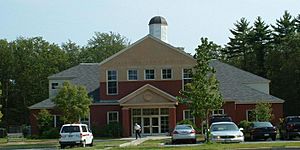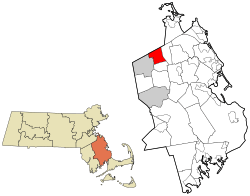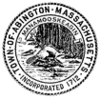Abington, Massachusetts facts for kids
Quick facts for kids
Abington, Massachusetts
|
|||
|---|---|---|---|

Abington Town Offices
|
|||
|
|||

Location in Plymouth County in Massachusetts
|
|||
| Country | United States | ||
| State | Massachusetts | ||
| County | Plymouth | ||
| Settled | 1668 | ||
| Incorporated | 1712 | ||
| Named for | Abingdon-on-Thames, UK | ||
| Government | |||
| • Type | Open Town Meeting | ||
| Area | |||
| • Total | 10.19 sq mi (26.39 km2) | ||
| • Land | 9.96 sq mi (25.80 km2) | ||
| • Water | 0.23 sq mi (0.59 km2) | ||
| Elevation | 108 ft (33 m) | ||
| Population
(2020)
|
|||
| • Total | 17,062 | ||
| • Density | 1,713.05/sq mi (661.42/km2) | ||
| Time zone | UTC−5 (Eastern) | ||
| • Summer (DST) | UTC−4 (Eastern) | ||
| ZIP Code |
02351
|
||
| Area code | 339/781 | ||
| FIPS code | 25-00135 | ||
| GNIS feature ID | 0618336 | ||
| Website | www.abingtonma.gov | ||
Abington is a town in Massachusetts, located in Plymouth County. It's about 20 miles (32 km) southeast of Boston. In 2020, about 17,062 people lived there.
Contents
History
Before European settlers arrived, the local Native Americans called this area Manamooskeagin. This name meant "great green place of shaking grass." Two streams in the area were named for the many beavers living there: Schumacastacut (meaning "upper beaver brook") and Schumacastuscacant ("lower beaver brook").
European settlers first came to Abington in 1668. At that time, the land included what are now the towns of Bridgewater, Rockland, Whitman, and parts of Hanover.
The town officially became a town (was incorporated) in 1712. Six years earlier, Governor Joseph Dudley named it Abington. This was to honor Anne Venables-Bertie, Countess of Abingdon. She was the wife of the second Earl of Abingdon. She helped Governor Dudley get his job from Queen Anne. The Earl of Abingdon's name came from Abingdon-on-Thames in England. Even though the governor's original order said "Abingdon," a note on the document changed the spelling to "Abington," which it has been ever since.
Industry and Change
In 1769, a factory that worked with iron was built in Abington. Later, in 1815, a man named Jesse Reed invented a machine that could make tacks (small nails) very quickly. This invention helped the shoe industry grow in the town.
During the 1800s and early 1900s, making boots and shoes was the main business in Abington. In fact, almost half of the shoes worn by the Union Army during the Civil War came from factories in Abington!
From 1846 to 1865, Abington was an important center for the abolitionist movement. This movement worked to end slavery in the United States.
Later, in 1874 and 1875, parts of Abington became their own separate towns: Rockland and Whitman.
In 1893, there was a disagreement between the town and the New York, New Haven & Hartford Railroad. The town wanted to build a streetcar line that crossed the railroad tracks. This led to a small riot. In the end, the town built the line. As a "peace offering," the railroad built the North Abington Depot building. It was designed in a special style by a famous architect named H. H. Richardson.
Economy
Today, Abington is mostly a place where people live. There are also some small factories.
Geography
Abington covers about 10.19 square miles (26.39 square kilometers). Most of this area is land, with a small part being water.
Abington is located in Plymouth County. It is surrounded by other towns: Holbrook to the northwest, Weymouth to the northeast, Rockland to the east, Whitman to the south, and Brockton to the west. It's considered an inland town in the South Shore region of Massachusetts.
Waterways and Parks
Abington has two main waterways. The Shumatuscacant River forms part of the town's border with Brockton. Beaver Brook flows through the eastern part of town. This brook was very important in the past because it provided power for the shoe factories.
In the northwestern part of town, you'll find Ames Nowell State Park. This is a large forest area around Cleveland Pond, a great place for outdoor activities. Island Grove Pond was created in the 1700s when a dam was built on the Shumatuscacant River.
A part of the runways from the former South Weymouth Naval Air Station is also in the northeast corner of town. This air station closed in 1997.
Climate
Abington has a climate with hot, humid summers. The winters are generally mild to cool. This type of climate is called a humid subtropical climate.
Demographics
| Historical population | ||
|---|---|---|
| Year | Pop. | ±% |
| 1850 | 5,266 | — |
| 1860 | 8,527 | +61.9% |
| 1870 | 9,308 | +9.2% |
| 1880 | 3,697 | −60.3% |
| 1890 | 4,260 | +15.2% |
| 1900 | 4,489 | +5.4% |
| 1910 | 5,455 | +21.5% |
| 1920 | 5,787 | +6.1% |
| 1930 | 5,872 | +1.5% |
| 1940 | 5,708 | −2.8% |
| 1950 | 7,152 | +25.3% |
| 1960 | 10,607 | +48.3% |
| 1970 | 12,334 | +16.3% |
| 1980 | 13,517 | +9.6% |
| 1990 | 13,817 | +2.2% |
| 2000 | 14,605 | +5.7% |
| 2010 | 15,985 | +9.4% |
| 2020 | 17,062 | +6.7% |
| 2022 | 16,965 | −0.6% |
| * = population estimate. Source: United States Census records and Population Estimates Program data. Source: |
||
Based on the census from 2010, there were 15,985 people living in Abington. There were 6,080 households, which are groups of people living together in one home.
About 25.2% of the people in town were under 19 years old. About 11.9% were 65 years old or older. The average age in Abington was 39.5 years. Slightly more than half of the population (51.1%) were female, and 48.9% were male.
Education
The Abington School District has several schools.
- Beaver Brook Elementary School teaches students in kindergarten through second grade.
- Woodsdale Elementary School is for students in third and fourth grades.
- Abington Middle School serves students from fifth to eighth grades.
- Abington High School is for students in ninth to twelfth grades.
There is also a private school called Saint Bridget School. It teaches students from kindergarten through eighth grade.
Transportation
There are two main roads that go north and south through Abington: Route 18 and Route 58. Route 58 ends at Route 18 just north of the town line.
Two other roads, Route 123 and Route 139, run east to west through the town. Route 139 is the more northern of the two. There are no major highways that go directly into Abington. The town is located between Route 24 and Route 3.
A train line, which used to be part of the Old Colony Railroad, runs through the eastern part of town. Today, it's used by the MBTA's commuter rail line. This line connects Abington to places like Plymouth, Kingston, and Boston. There is a train stop in Abington near the intersection of Routes 123 and 58.
There isn't an airport in Abington. The closest major airport for national and international flights is Logan International Airport in Boston.
Events
On June 10, 2012, Abington celebrated its 300th anniversary of becoming a town!
The town holds several fun festivals every year:
- Founders Day (the first weekend in June)
- Halloween
- Christmas
Abington also hosts a Saint Patrick's Day parade each year. It's one of only three towns in Massachusetts that does this, along with Boston and Scituate.
Notable people
Many interesting people have come from Abington:
- Lucia H. Faxon Additon (1847-1919), a writer, teacher, and social reformer.
- Sarah Louise Arnold (1859-1943), the first dean of Simmons College and a national president of the Girl Scouts of the USA.
- "Big Brother" Bob Emery (1897–1982), a TV pioneer and a popular children's TV host.
- Mike Hazen (born 1976), the General Manager of the Arizona Diamondbacks baseball team.
- Jim Hickey (1920–1997), a pitcher for the Boston Braves in the 1940s.
- Aaron Hobart (1787–1858), who was a United States Congressman from Massachusetts.
- Charles Francis Meserve (1850–1936), an American school leader and president of Shaw University.
- Jared C. Monti (1975–2006), who received the Medal of Honor for his bravery.
- Bruce Allen Murphy, a professor and writer known for his books about judges.
- Larry Murphy (born 1972), a comedian and actor.
- John L. Sullivan (1858–1918), a famous bare-knuckle boxer and the first modern world heavyweight boxing champion.
- Michael Sullivan (born 1954), a former United States Attorney for the District of Massachusetts.
- Martha Ware (1917–2009), the first female selectman (a local government official) and the first female judge in Plymouth County.
See also
 In Spanish: Abington (Massachusetts) para niños
In Spanish: Abington (Massachusetts) para niños



